#Crude Oil
Text

#bootiful#curvy and cute#thick babe#huge butt#curvy brunette#thickwomen#big booyt#hot as fuck#curvy and beautiful#pawgbooty#thick legs#big tiddy gf#pawglife#dem tiddies#girl butts#bootie peach#crude oil#oil#cutie w a bootie#phat butt#perfect butt
6K notes
·
View notes
Text
"On Monday, March 13th, 2023, the Biden Administration approved the controversial Willow Project, the largest fossil fuel project the United States has reckoned with in decades. An $8 billion initiative of ConocoPhillips, Alaska’s largest crude oil producer, the project will nearly double existing oil production in the state."
"Long story short, over 30 years, Willow will release 260 million metric tons of carbon emissions into the atmosphere. That’s not good, especially given a United Nations climate report saying global carbon emissions rose in 2022. Also, Alaska Natives are sharply divided on this project. The blog explores the long history of extractive capitalism in Alaska, and how that has essentially put impoverished Indigenous people at the end of the barrel of a gun when it comes to fossil fuel projects like Willow."
The Lakota Law Project has another petition going around against a massive oil drilling project in Alaska. First link is the petition, second is their blog post about it with more information. Signing the petition is super easy. Just add your name and email.
#willow project#oil drilling#crude oil#petition#action#alaska#conocophillips#alaska natives#mmiw#mmiwawareness#climate#climate change#climate emergency#climate action#climate activism#activism#indigenous#indigenous people#president biden#joe biden
619 notes
·
View notes
Text
223 notes
·
View notes
Text
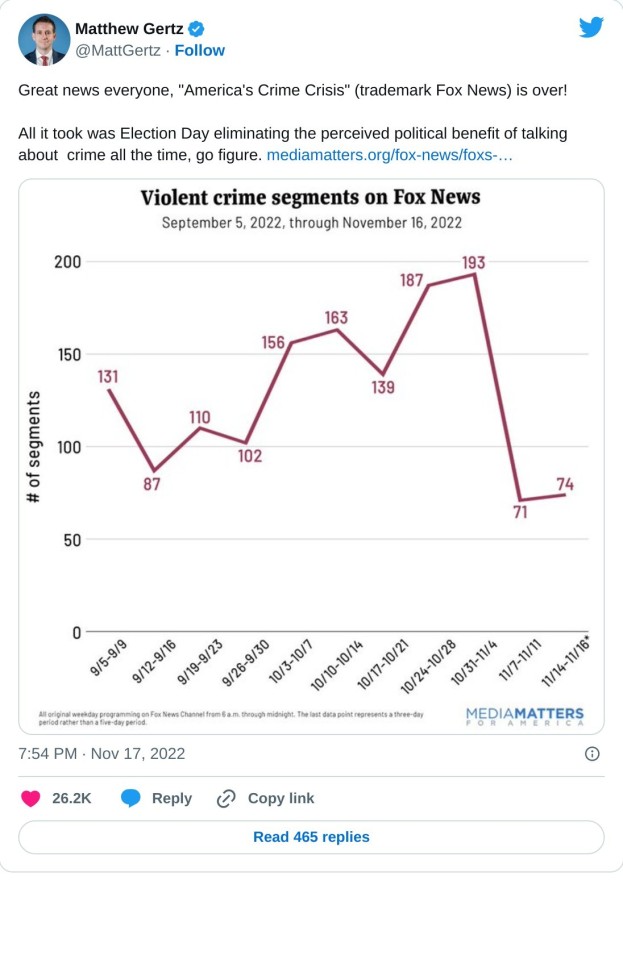
You can view the data HERE
Also...

#us politics#news#2022#twitter#tweet#republicans#conservatives#gop#fake news#crime#crime statistics and rates#violent crime rate#crime rates#oil and gas#gas prices#crude oil#big oil#opec#2022 elections#2022 midterms#fox news#matthew gettz#media matters for america#cnbc#stock market#stocks#@TheRealHoarse
502 notes
·
View notes
Text

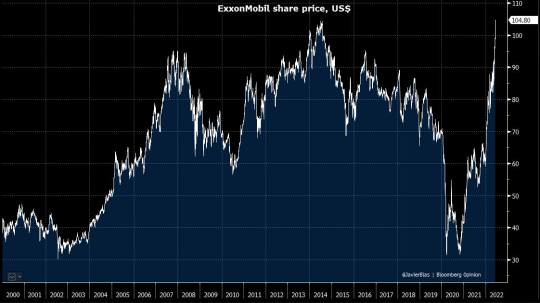
The price of crude oil in US dollars hits highest point (and still rising) since 2008. If we compare the current price with euros and pounds, we can see that we are passed the 2008 level.
Hence why the United States' regime now has allowed Venezuelan oil to Europe. Because, at all costs, the united western ruling class wants to avoid popular uprisings.
Meanwhile, US oil company ExxonMobil hit an all-time high of $104.8 per share, as you can see on the second picture.
286 notes
·
View notes
Text

So glad I got to take differential equations for this 😐
#dank memes#fresh memes#funny memes#memes#lol#so true#college#school#funny but true#differential equations#engineering#duct tape#crude oil
144 notes
·
View notes
Text
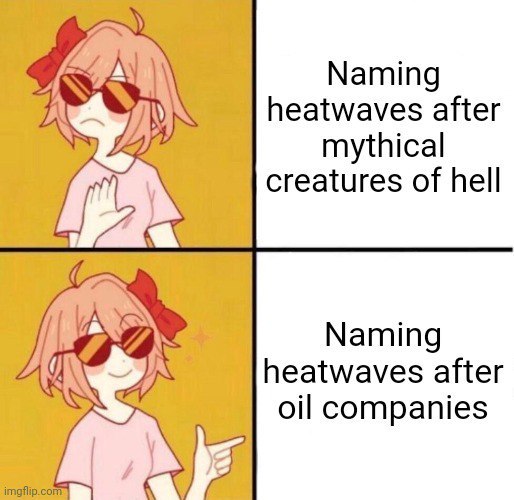
"The Exxon Mobil heatwave killed 3000 people this week..."
#exxonmobil#exxon#mobil#crude oil#oil painting#olive oil#oilers lb#essential oils#oil on canvas#oil#oil companies#oil control face wash#climate justice#climate leaders#climate science#climate activists ‘may try to wreck the rollout of voter id measures at the local elections’#climate emergency#climate change#climate crisis#climate and environment#climate action#jail climate criminals#ausgov#politas#auspol#tasgov#taspol#australia#neoliberal capitalism#fuck neoliberals
21 notes
·
View notes
Text



AIAT (new sketches:) )
15 notes
·
View notes
Text

#south dakota#sinclair oil dinosaur#gas station#casino#atm#ruralcore#rural america#rural gothic#rural living#rural#small town#small town life#midwest america#midwest gothic#crude oil#coffee cup#fuel stop#road trip#travel photography
9 notes
·
View notes
Text

Oil is my favorite 🤤💦🧴
#bootiful#curvy and cute#thick babe#huge butt#curvy brunette#thickwomen#big booyt#hot as fuck#curvy and beautiful#pawgbooty#thick legs#pawglife#girl butts#bootie peach#crude oil#oil#coconut oil#twerking
319 notes
·
View notes
Text
By Julia Conley
Common Dreams
April 15, 2024
Climate action groups are vehemently rejecting the Biden administration's claim that the approval of a new offshore oil terminal—planned to be the largest in the U.S.—is in the "national interest," after the U.S. Department of Transportation announced the project had met several federal requirements and could begin operations by 2027.
The agency's Maritime Administration said last week that Enterprise Product Partners, a Houston-based pipeline company, had been granted a deepwater port license to build the Sea Port Oil Terminal (SPOT) near Freeport, Texas following a five-year federal review process.
The federal government determined the $1.8 billion terminal project had undergone sufficient environmental impact reviews and would overall benefit the country—even as it was projected by the Sierra Club, which has fought SPOT for several years, to emit greenhouse gases equivalent to those of nearly 90 coal-fired power plants.
"The evidence is clear that SPOT would be catastrophic to the climate, wildlife, and frontline communities of the Gulf," said Devorah Ancel, senior attorney with the Sierra Club. "It threatens the future existence of the endangered Rice's whale with a population of less than fifty, and its ozone pollution would compromise the health of thousands of Gulf residents who have endured decades of fossil fuel industry pollution. Make no mistake, SPOT is not in the national interest."
The project is expected to include two pipelines that would carry crude oil to the deepwater port each day, enabling the export of 2 million barrels of crude oil, loaded onto two supertankers at once, daily.
"Nothing about this project is in alignment with Biden's climate and environmental justice goals," said Kelsey Crane, senior policy advocate at Earthworks. "The communities that will be impacted by SPOT have once again been ignored and will be forced to live with the threat of more oil spills, explosions, and pollution. The best way to protect the public and the climate from the harms of oil is to keep it in the ground."
Allie Rosenbluth, U.S. manager at Oil Change International, noted that the project has been approved despite the International Energy Agency's clear assessment in 2021 that "all new investments in oil and gas projects must stop if the world is going to reach its climate goals," including limiting planetary heating to 1.5°C.
"The Biden administration's decision to approve the Sea Port Oil Terminal is a grave mistake. This approval will only harm local communities and ecosystems, and lead to even more devastating impacts of the climate crisis," said Rosenbluth. "The U.S. is already the largest producer of oil and gas and has the largest expansion plans globally. Instead of continuing this legacy of harm by approving fossil fuel projects, President Biden should be listening to the science and the masses of his constituents calling for an end to fossil fuels."
The direct action group Climate Defiance expressed doubt that the approval of SPOT will help Biden win over any voters as the 2024 election approaches.
Nine in 10 Democratic voters and Democratic-leaning independents told Pew Research Center last year that they believe the U.S. should prioritize developing renewable energy sources—and two-thirds of Republican voters under age 30 agreed.
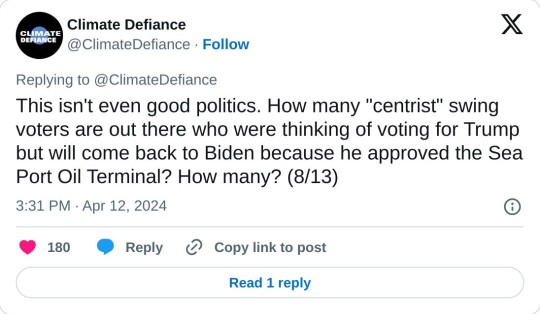
"This project would be the single-largest oil export terminal in the U.S." said the group. "We are being boiled alive here, literally burned to death by 'moderate' politicians who see fit to torch us in the name of quarterly profits. How can we live like this? How can this go on?"
Last year was the hottest on record, and the first three months of 2024 have each broken records for high global temperatures. Scientists found last year that climate disasters including wildfires in Canada and extreme heat in Europe were made far more likely by fossil-fueled planetary heating.
Local organizers in Texas condemned the Biden administration's decision to ignore campaigners who have warned of the danger SPOT poses to marine habitats as well as people who live in the area where two crude oil pipelines have now been given final approval to run.
"We continue to struggle to see why Biden and [Transportation Secretary Pete] Buttigieg prefer to protect the corporate profits of billion-dollar oil giants like Enbridge and Enterprise over the hardcore objections of the people who would have to live with the consequences of pipelines criss-crossing our beaches," said Trevor Carroll, Brazoria County lead organizer with Texas Campaign for the Environment. "If you care about environmental justice and the climate, you just can't support a monstrosity like SPOT. The local community and the global climate justice movement are continuing to fight... This is not over."
Melanie Oldham, director of Better Brazoria, said SPOT will be "an oil spill waiting to happen that would not only lower property value, but harm our local ecosystems, ecotourism, beaches, recreation, and kill marine life like the endangered Rice's whale and Kemp's Ridley sea turtles."
"Those of us residents, beachgoers, and voters that have for the past four years opposed the SPOT offshore terminal and pipelines are very disappointed with the approval of the project license," said Oldham. "President Biden has again broken promises to protect frontline communities in Surfside and Freeport."
The administration's approval came three months after the White House announced it was delaying consideration of new gas export terminals, and the same day the federal government said fossil fuel companies will have to pay higher royalties in order to drill on federal lands.
But those climate actions paired with the SPOT approval amount only to "flip flopping," said Climate Defiance.
"It is not enough that the administration stopped new gas exports if they are going to back stab us with this death-sentence decision now," said the group. "This is not us being 'ungrateful.' This is the science. The pure, unvarnished, science."
#climate defiance#climate emergency#fossil fuels#crude oil#texas#enterprise product partners#sea port oil terminal#earthjustice#sierra club#joe biden#pete buttigieg#u.s. department of transportation
4 notes
·
View notes
Text
Having grown up on a farm in Uganda, I have seen the damage of the climate crisis firsthand. My family lived in a small village near the banks of Lake Victoria, the second largest freshwater lake in the world, and my childhood was spent climbing trees, planting seeds, and eating fruit straight from the trees. We grew bananas, guavas, beans, cassava, sugarcane, and coffee. It sounds idyllic but I remember the first time I realised climate change would affect us—it was a rainy season unlike any we had seen before. For days and nights heavy rain battered the fields and strong winds bent and broke the crops until they were unsavable. Not only did the rains affect us financially, but I missed months of my schooling because flooding blocked the roads and I couldn’t get to school.
Burning fossil fuels, which releases carbon pollution into the air and causes our world to overheat, is the number one cause of the climate chaos we’re facing. 2024 may be even hotter than 2023, resulting in even more catastrophic weather.
But there is still hope. Those with power must act now, and the insurance industry holds more power than most to slow the crisis and protect our future. Without insurance, fossil fuel projects can’t operate. If insurance companies updated their policies and refused to insure new fossil fuel projects, there would be no new oil pipelines, liquefied natural gas terminals, or dirty coal mines. If they focused instead on insuring clean, safe energy and a just transition, our communities and our world would be safer for current and future generations.
The insurance industry’s role is to protect and manage risk, but right now it is failing spectacularly at both. Instead of protecting communities, it’s adding fuel to the fire by continuing to insure new fossil fuel projects. The East African Crude Oil Pipeline (EACOP) is a prime example. This proposed pipeline would run 1,443 kilometers between Hoima in Uganda and Tanga in Tanzania, but the project has stalled as it has not yet secured full insurance and financing due to the many human and environmental rights abuses associated with it. These include the harassment and imprisonment of peaceful protesters, the disturbing of sacred burial grounds, and the forcible removal of communities to make way for the pipeline. If EACOP gets insured and goes ahead, it will cross 200 rivers and pass through Lake Victoria’s water basin. Over 40 million people depend on the lake for survival, as well as countless animal species; if the pipe leaks and spills oil into the water, what will happen to them?
The corporations behind EACOP say it will “unlock East Africa’s potential,” but let’s be clear: It is neocolonialism at its best, and the only ones who will gain are the foreign companies set to profit. EACOP will irrevocably damage East Africa’s biodiversity, displace thousands of people, destroy their livelihoods and communities, and unleash 32.3 million metric tons of carbon into the atmosphere per year, setting off a climate bomb that will make our world overheat to devastating levels. The International Energy Agency has stated that there can be no new oil pipelines if we are to save the future, and yet insurance companies including AIG, Tokio Marine, Chubb, Hiscox, and Lloyd’s of London still refuse to rule out insuring EACOP.
#enviromentalism#ecology#pipeline#crude oil#climate change#climate crisis#east africa#uganda#tanzania#neocolonialism#East African Crude Oil Pipeline#EACOP#insurance companies
2 notes
·
View notes
Text

#us politics#2022#twitter#tweet#republicans#conservatives#donald trump#gop#republicans be like#conservatives be like#saudi arabia#saudi royal family#opec#opec output#gas prices#big oil#oil and gas#crude oil#raw story#@goodpoliticguy
59 notes
·
View notes
Link
“The Los Angeles City Council voted unanimously on Friday to ban drilling of new oil and gas wells and phase out existing ones over the next 20 years.
The vote comes after more than a decade of complaints from city residents that pollution drifting from wells was affecting their health.
“Hundreds of thousands of Angelenos have had to raise their kids, go to work, prepare their meals (and) go to neighborhood parks in the shadows of oil and gas production,” said Los Angeles City Council president Paul Krekorian, one of the councilmembers who introduced this measure. “The time has come …. when we end oil and gas production in the city of Los Angeles...”
According to the city controller’s office there were 780 active and 287 idle wells within city boundaries in 2018. An idle well is one that is not operating, but neither has it been permanently sealed, so it could be brought back into production...
Researchers from the University of Southern California in a study in 2021 found that people living near wells in two Los Angeles neighborhoods — University Park and Jefferson Park — reported significantly higher rates of wheezing, eye and nose irritation, sore throat and dizziness than neighbors living farther away. Both of those communities are predominantly non-white with large Black and Latino communities, according to the U.S. Census.
The push to ban drilling in the City of Los Angeles is part of a region-wide effort to shut down oil and gas extraction throughout the county of Los Angeles, with similar measures covering Culver City and unincorporated parts of Los Angeles County passed in 2021.
“In Los Angeles, we sit on the largest urban oil deposit in the world,” said councilmember Marqueece Harris-Dawson ahead of the vote. “So if Los Angeles can do it, cities around the world can do it.”” -via PBS News Hour, 12/2/22
#los angeles#los angeles city council#oil and gas drilling#california#pollution#fossil fuels#crude oil#health disparities#environmental racism#good news#hope
23 notes
·
View notes
Text
Human Factors Engineering (HFE): Making Oil and Gas Facilities Safer and More Efficient
Human Factors Engineering (HFE) is the application of scientific principles to the design of products, systems, and environments to optimize human performance and safety. HFE is particularly important in the oil and gas industry, where workers face a variety of hazards and where even a small mistake can have catastrophic consequences.
There are many ways that HFE can be used to improve the design of oil and gas facilities. For example, HFE can be used to:
Design controls that are easy to see and reach, and that are clearly labeled.
Design layouts that minimize the risk of accidents and injuries.
Provide workers with the information and training they need to perform their jobs safely and efficiently.
Create a positive work environment that supports worker well-being.
Here are a few specific examples of how HFE has been used to improve the design of oil and gas facilities:
Color-coding pipes and valves to make it easier for workers to identify them.
Using non-slip surfaces to reduce the risk of falls.
Designing control panels that are easy to use and that minimize the risk of errors.
Providing workers with clear and concise instructions on how to perform their jobs safely.
Creating break rooms and other spaces where workers can relax and socialize.
By incorporating HFE principles into the design of oil and gas facilities, companies can improve safety, efficiency, and worker well-being.
Here is a more detailed example of how HFE was used to improve the design of an oil and gas facility:
In one case, an oil and gas company was experiencing a high rate of accidents involving workers tripping and falling on slippery surfaces. The company hired an HFE consultant to help them identify and address the problem.
The HFE consultant conducted a site visit and interviewed workers to learn more about the problem. The consultant found that the slippery surfaces were caused by a combination of factors, including oil and grease spills, rainwater, and condensation.
The consultant recommended a number of solutions to the company, including:
Installing non-slip surfaces in areas where workers are likely to walk.
Improving drainage in areas where rainwater and condensation accumulate.
Providing workers with training on how to avoid slips and falls.
The company implemented the consultant's recommendations, and the rate of accidents involving slips and falls decreased significantly.
This is just one example of how HFE can be used to improve the safety of oil and gas facilities. HFE can also be used to improve efficiency and worker well-being. For example, HFE can be used to design workstations that are ergonomically correct and that minimize fatigue. HFE can also be used to develop training programs that are effective and engaging.
Here are some additional benefits of using HFE in the oil and gas industry:
Reduced costs: HFE can help to reduce the costs associated with accidents and injuries.
Improved productivity: HFE can help to improve productivity by reducing errors and improving efficiency.
Increased employee satisfaction: HFE can help to create a safer and more comfortable work environment, which can lead to increased employee satisfaction.
Overall, HFE is a valuable tool that can be used to improve safety, efficiency, and worker well-being in the oil and gas industry.
Conclusion
HFE is a valuable tool that can be used to improve safety, efficiency, and worker well-being in the oil and gas industry. By incorporating HFE principles into the design of oil and gas facilities, companies can create a safer and more productive work environment for their employees.
#human factor engineering#oilandgas#chemical industry#crude oil#health and safety#industrial safety animation#petrol#refinery#riskassessment#riskmanagement#engineering
5 notes
·
View notes
Text

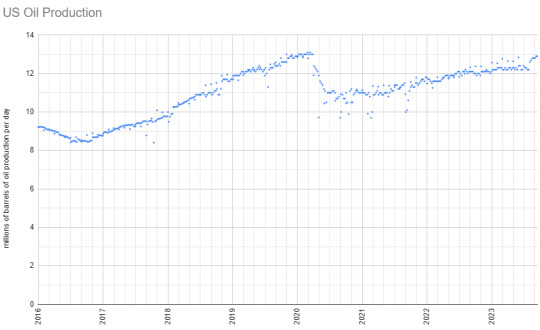
These charts are based on data from the Energy Information Agency (EIA), the government agency that the oil and gas industry relies on to provide accurate measures of US and international energy production, imports, exports, and other data.
The EIA provides US oil production data compiled monthly since 1920 or compiled weekly since 1983. Both data sets are included in the above charts.
So, in summary, US oil production grew sharply starting in 2011, peaked and began to fall in 2015, bottomed out and started to recover by Oct 2016, recovered by 2018, reached an all-time peak by Feb 2020, then crashed again until Jun 2020, and has recovered ever since back to nearly the all-time peak once again.
For those that love to assign the US President all credit for oil production, there are serious upturns under Obama (2011-2016), Trump (2017-2019), and Biden (2021-present) and serious downturns under Obama (2015-6) and Trump (2020). Make of that what you will.
#data#oil and gas#oil production#usa#us politics#uspol#american politics#energy policy#crude oil#oil prices
2 notes
·
View notes